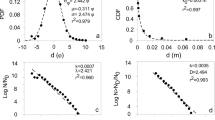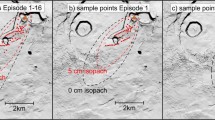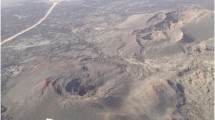Abstract
On 17 June 1996, Ruapehu volcano, New Zealand, produced a sustained andesitic sub-Plinian eruption, which generated a narrow tephra-fall deposit extending more than 200 km from the volcano. The extremely detailed data set from this eruption allowed methods for the determination of total grain-size distribution and volume of tephra-fall deposits to be critically investigated. Calculated total grain-size distributions of tephra-fall deposits depend strongly on the method used and on the availability of data across the entire dispersal area. The Voronoi Tessellation method was tested for the Ruapehu deposit and gave the best results when applied to a data set extending out to isomass values of <1 g m−2. The total grain-size distribution of a deposit is also strongly influenced by the very proximal samples, and this can be shown by artificially constructing subsets from the Ruapehu database. Unless the available data set is large, all existing techniques for calculations of total grain-size distribution give only apparent distributions. The tephra-fall deposit from Ruapehu does not show a simple exponential thinning, but can be approximated well by at least three straight-line segments or by a power-law fit on semi-log plots of thickness vs. (area)1/2. Integrations of both fits give similar volumes of about 4×106 m3. Integration of at least three exponential segments and of a power-law fit with at least ten isopach contours available can be considered as a good estimate of the actual volume of tephra fall. Integrations of smaller data sets are more problematic.









Similar content being viewed by others
References
Barberi F, Macedonio G, Pareschi MT, Santacroce R (1990) Mapping the tephra fallout risk: an example from Vesuvius, Italy. Nature 344:142–144
Blower JD, Keating JP, Mader HM, Phillips JC (2003) The evolution of bubble size distributions in volcanic eruptions. J Volcanol Geotherm Res 120(1–2):1–23
Bohm G, Galuppo P, Vesnaver A (2000) 3D adaptive tomography using Delaunay triangles and Voronoi polygons. Geophys Prospect 48:723–744
Bonadonna C, Phillips JC (2003) Sedimentation from strong volcanic plumes. J Geophys Res 108(B7):2340–2368
Bonadonna C, Ernst GGJ, Sparks RSJ (1998) Thickness variations and volume estimates of tephra fall deposits: the importance of particle Reynolds number. J Volcanol Geotherm Res 81:173–187
Bonadonna C, Macedonio G, Sparks RSJ (2002a) Numerical modelling of tephra fallout associated with dome collapses and Vulcanian explosions: application to hazard assessment on Montserrat. In: Druitt TH, Kokelaar BP (eds) The eruption of Soufrière Hills Volcano, Montserrat, from 1995 to 1999. Memoir, Geological Society, London, pp 517–537
Bonadonna C, Mayberry GC, Calder ES, Sparks RSJ, Choux C, Jackson P, Lejeune AM, Loughlin SC, Norton GE, Rose WI, Ryan G, Young SR (2002b) Tephra fallout in the eruption of Soufrière Hills Volcano, Montserrat. In: Druitt TH, Kokelaar BP (eds) The eruption of Soufrière Hills Volcano, Montserrat, from 1995 to 1999. Memoir, Geological Society, London, pp 483–516
Brown KQ (1979) Voronoi Diagrams from Convex Hulls. Inform Proc Lett 9(5):223–228
Bursik MI, Sparks RSJ, Gilbert JS, Carey SN (1992) Sedimentation of tephra by volcanic plumes: I. Theory and its comparison with a study of the Fogo A Plinian deposit, Sao Miguel (Azores). Bull Volcanol 54:329–344
Carey SN, Sigurdsson H (1982) Influence of particle aggregation on deposition of distal tephra from the May 18, 1980, eruption of Mount St-Helens volcano. J Geophys Res 87(B8):7061–7072
Connor CB, Hill BE, Winfrey B, Franklin NM, La Femina PC (2001) Estimation of volcanic hazards from tephra fallout. Natural Hazards Rev 2:33–42
Cronin SJ, Hedley MJ, Neall VE, Smith RG (1998) Agronomic impact of tephra fallout from the 1995 and 1996 Ruapehu Volcano eruptions, New Zealand. Environ Geol 34:21–30
Dupuis F, Sadoc JF, Mornon JP (2004) Protein secondary structure assignment through Voronoi tessellation. Proteins-Structure Funct Bioinform 55:519–528
Duyckaerts C, Godefroy G (2000) Voronoi tessellation to study the numerical density and the spatial distribution of neurones. J Chem Neuroanat 20:83–92
Fierstein J, Hildreth W (1992) The plinian eruptions of 1912 at Novarupta, Katmai National Park, Alaska. Bull Volcanol 54:646–684
Fierstein J, Nathenson M (1992) Another look at the calculation of fallout tephra volumes. Bull Volcanol 54:156–167
Froggatt PC (1982) Review of methods estimating rhyolitic tephra volumes; applications to the Taupo Volcanic Zone, New Zealand. J Volcanol Geotherm Res 14:1–56
Gowda IG, Kirkpatrick DG, Lee DT, Naamad A (1983) Dynamic Voronoi Diagrams. IEEE Trans Inform Theory 29:724–731
Haydon DT, Pianka ER (1999) Metapopulation theory, landscape models, and species diversity. Ecoscience 6:316–328
Hildreth W, Drake RE (1992) Volcano Quizapu, Chilean Andes. Bull Volcanol 54:93–125
Houghton BF, Wilson CJN (1998) Fire and water: the physical roles of water in caldera eruptions at Taupo and Okataina volcanic centres. Water–Rock Interaction, Taupo, New Zealand, pp 25–30
Hurst AW, Turner R (1999) Performance of the program ASHFALL for forecasting ashfall during the 1995 and 1996 eruptions of Ruapehu volcano. New Zealand J Geol Geophys 42:615–622
Inman DL (1952) Measures for describing the size distribution of sediments. J Sediment Petrol 22:125–145
Jasny (1988) Exploiting the insights from protein structure. Science 240:722–723
Kaminski E, Jaupart C (1998) The size distribution of pyroclasts and the fragmentation sequence in explosive volcanic eruptions. J Geophys Res-Solid Earth 103(B12):29759–29779
Klein R (1989) Concrete and abstract Voronoi diagrams. Springer Lecture Notes in Computer Science #400, Berlin Heidelberg New York
Moore KR, Duffell H, Nicholl A, Searl A (2002) Monitoring of airborne particulate matter during the eruption of Soufrière Hills Volcano, Montserrat. In: Druitt TH, Kokelaar BP (eds) The eruption of Soufrière Hills Volcano, Montserrat, from 1995 to 1999. Memoir, Geological Society, London, pp 557–566
Murrow PJ, Rose WI, Self S (1980) Determination of the total grain size distribution in a Vulcanian eruption column, and its implications to stratospheric aerosol perturbation. Geophys Res Lett 7:893–896
Nelson RA (1979) Natural fracture systems: descriptions and classification. Bull Am Assoc Petrol Geol 63:2214–2219
Okabe A, Boots B, Sugihara K (1992) Spatial tessellations: concepts and applications of Voronoi diagrams. Wiley, Chichester
Parfitt EA (1998) A study of clast size distribution, ash deposition and fragmentation in a Hawaiian-style volcanic eruption. J Volcanol Geotherm Res 84:197–208
Prata AJ, Grant IF (2001) Retrieval of microphysical and morphological properties of volcanic ash plumes from satellite data: application to Mt Ruapehu, New Zealand. Q J R Meteorol Soc 127:2153–2179
Pyle DM (1989) The thickness, volume and grainsize of tephra fall deposits. Bull Volcanol 51:1–15
Pyle DM (1990) New estimates for the volume of the Minoan eruption. In: Hardy DA (ed) Thera and the Aegean World, III. Thera Foundation, London, pp 113–121
Pyle DM (1995) Assessment of the minimum volume of tephra fall deposits. J Volcanol Geotherm Res 69:379–382
Rose WI (1993) Comment on another look at the calculation of fallout tephra volumes. Bull Volcanol 55:372–374
Rose WI, Bonis S, Stoiber RE, Keller M, Bickford T (1973) Studies of volcanic ash from two recent Central American eruptions. Bull Volcanol 37:338–364
Sarna-Wojcicki AM, Shipley S, Waitt JR, Dzurisin D, Wood SH (1981) Areal distribution thickness, mass, volume, and grain-size of airfall ash from the six major eruptions of 1980. US Geol Surv Prof Pap 1250:577–600
Scasso R, Corbella H, Tiberi P (1994) Sedimentological analysis of the tephra from 12–15 August 1991 eruption of Hudson Volcano. Bull Volcanol 56:121–132
Sigurdsson H, Carey S, Cornell W, Pescatore T (1985) The eruption of Vesuvius in a.d. 79. Nat Geogr Res 1:332–387
Sparks RSJ, Wilson L, Sigurdsson H (1981) The pyroclastic deposits of the 1875 eruption of Askja, Iceland. Phil Trans R Soc Lond 229:241–273
Sparks RSJ, Bursik MI, Ablay GJ, Thomas RME, Carey SN (1992) Sedimentation of tephra by volcanic plumes .2. Controls on thickness and grain-size variations of tephra fall deposits. Bull Volcanol 54:685–695
Thorarinsson S (1967) The eruption of Hekla 1947–1948. Vidindafélag Islendinga Reykjavik
Walker GPL (1980) The Taupo Pumice: product of the most powerful known (Ultraplinian) eruption? J Volcanol Geotherm Res 8:69–94
Walker GPL (1981a) Characteristics of two phreatoplinian ashes, and their water-flushed origin. J Volcanol Geotherm Res 9:395–407
Walker GPL (1981b) Plinian eruptions and their products. Bull Volcanol 44 223–240
Walker GPL (1981c) The Waimihia and Hatepe plinian deposits from the rhyolitic Taupo Volcanic Centre. NZ J Geol Geophys 24:305–324
Walker GPL, Croasdale R (1971) Two plinian-type eruptions in the Azores. J Geol Soc Lond 127:17–55
Walker GPL, Self S, Wilson L (1984) Tarawera, 1886, New Zealand — a basaltic Plinian fissure eruption. J Volcanol Geotherm Res 21:61–78
Wen S, Rose WI (1994) Retrieval of sizes and total masses of particles in volcanic clouds using AVHRR bands 4 and 5. J Geophys Res 99:5421–5431
Wilkinson BH, Drummond CN, Diedrich NW, Rothman ED (1999) Poisson processes of carbonate accumulation on Paleozoic and Holocene platforms. J Sediment Res 69:338–350
Williams SN, Self S (1983) The October 1902 Plinian eruption of Santa Maria volcano, Guatemala. J Volcanol Geotherm Res 16:33–56
Wohletz KH, Sheridan MF, Brown WK (1989) Particle-size distributions and the sequential fragmentation/transport theory applied to volcanic ash. J Geophys Res 94(B11):15703–15721
Zhan XJ, Troy JB (2000) Modeling cat retinal beta-cell arrays. Visual Neurosci 17:23–39
Acknowledgements
The authors are grateful to Steve Carey, Dave Pyle and Steve Sparks for constructive review of the manuscript and to Jon Blower for helpful discussion on the application of the Voronoi tessellation method. The Ruapehu data set was collected with the assistance of a large number of New Zealand colleagues including Thor Thordarson, Mike Rosenberg, Colin Wilson, David Johnston, Rod Burtt, Bruce Christiansen, Will Esler, Barbara Hobden, Katy Hodgson, Zinzuni Jurado-Chichay, Barry Lowe, Richard Smith, Jeff Willis and Vince Udy. This work was supported by an EC Marie Curie PhD Fellowship at Bristol University (UK), by NSF-EAR-0310096, NSF-EAR-012579 and by several grants by the New Zealand Foundation for Research and Sciences Technology.
Author information
Authors and Affiliations
Corresponding author
Additional information
Editorial responsibility: H. Shinohara
Rights and permissions
About this article
Cite this article
Bonadonna, C., Houghton, B.F. Total grain-size distribution and volume of tephra-fall deposits. Bull Volcanol 67, 441–456 (2005). https://doi.org/10.1007/s00445-004-0386-2
Received:
Accepted:
Published:
Issue Date:
DOI: https://doi.org/10.1007/s00445-004-0386-2




